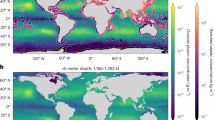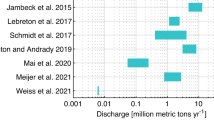Abstract
Increasing plastic waste has triggered global concerns for the potential detrimental effects on marine ecosystems. The impact of plastic reaches beyond the immediate harm to marine life to encompass the marine biogeochemical cycle and the global carbon budget. We investigate these effects by integrating an oceanic plastic simulation with a marine ecosystem model. We find that oceanic plastic could disturb the marine carbon cycle through three pathways: the plastic carbon buried in sediments, the release of dissolved organic carbon from water-column plastic and the toxicity effect on marine phytoplankton. Our scenario analysis suggests that there are 0.70 (0.13–3.8) Tg of plastics entering the ocean every year, however, the overall impact of oceanic plastics on decreasing ocean carbon uptake could reach 12.1 TgC yr−1. Our model predicts that the global plastic released into the ocean could result in up to 1.6 PgC of lost ocean carbon uptake and storage by 2050, given the foreseeable growth of plastic production and its long-lasting impacts. We urge comprehensive control policies to mitigate the losses caused by marine plastics both in ecosystem integrity and addressing climate change.
This is a preview of subscription content, access via your institution
Access options
Access Nature and 54 other Nature Portfolio journals
Get Nature+, our best-value online-access subscription
$32.99 / 30 days
cancel any time
Subscribe to this journal
Receive 12 digital issues and online access to articles
$119.00 per year
only $9.92 per issue
Buy this article
- Purchase on SpringerLink
- Instant access to full article PDF
Prices may be subject to local taxes which are calculated during checkout




Similar content being viewed by others
Data availability
All data are available in the Article, Supplementary Information or via Zenodo at https://zenodo.org/records/16722412 (ref. 57). Correspondence should be addressed to Y.Z.
Code availability
All model code is available via Zenodo at https://zenodo.org/records/16722412 (ref. 57).
References
Zhang, Y. et al. Plastic waste discharge to the global ocean constrained by seawater observations. Nat. Commun. 14, 1372 (2023).
Fu, Y. et al. Modeling atmospheric microplastic cycle by GEOS-Chem: an optimized estimation by a global dataset suggests likely 50 times lower ocean emissions. One Earth 6, 705–714 (2023).
Kooi, M., Nes, E. H. V., Scheffer, M. & Koelmans, A. A. Ups and downs in the ocean: effects of biofouling on vertical transport of microplastics. Environ. Sci. Technol. 51, 7963–7971 (2017).
Allen, S. et al. Evidence of free tropospheric and long-range transport of microplastic at Pic du Midi Observatory. Nat. Commun. 12, 7242 (2021).
Cressey, D. Bottles, bags, ropes and toothbrushes: the struggle to track ocean plastics. Nature 536, 263–265 (2016).
Galgani, L. & Loiselle, S. A. Plastic pollution impacts on marine carbon biogeochemistry. Environ. Pollut. 268, 115598 (2021).
Dutkiewicz, S., Follows, M. J. & Bragg, J. G. Modeling the coupling of ocean ecology and biogeochemistry. Glob. Biogeochem. Cycles 23, 2008GB003405 (2009).
Moran, M. A. et al. Deciphering ocean carbon in a changing world. Proc. Natl Acad. Sci. USA 113, 3143–3151 (2016).
Galgani, L. et al. Hitchhiking into the deep: how microplastic particles are exported through the biological carbon pump in the North Atlantic Ocean. Environ. Sci. Technol. 56, 15638–15649 (2022).
Roberts, C. et al. Microplastics may reduce the efficiency of the biological carbon pump by decreasing the settling velocity and carbon content of marine snow. Limnol. Oceanogr. 69, 1918–1928 (2024).
Wu, N., Grieve, S. W. D., Manning, A. J. & Spencer, K. L. Flocs as vectors for microplastics in the aquatic environment. Nat. Water 2, 1082–1090 (2024).
IPCC. Climate Change 2021: The Physical Science Basis (Cambridge Univ. Press, 2023).
Regnier, P. et al. Anthropogenic perturbation of the carbon fluxes from land to ocean. Nat. Geosci. 6, 597–607 (2013).
Alongi, D. M. Blue Carbon (Springer, 2018).
Smeaton, C. Augmentation of global marine sedimentary carbon storage in the age of plastic. Limnol. Oceanogr. Lett. 6, 113–118 (2021).
Romera-Castillo, C., Pinto, M., Langer, T. M., Álvarez-Salgado, X. A. & Herndl, G. J. Dissolved organic carbon leaching from plastics stimulates microbial activity in the ocean. Nat. Commun. 9, 1430 (2018).
Kvale, K., Hunt, C., James, A. & Koeve, W. Regionally disparate ecological responses to microplastic slowing of faecal pellets yields coherent carbon cycle response. Front. Mar. Sci. 10, 1111838 (2023).
Galgani, L. et al. Marine plastics alter the organic matter composition of the air–sea boundary layer, with influences on CO2 exchange: a large-scale analysis method to explore future ocean scenarios. Sci. Total Environ. 857, 159624 (2023).
Sendra, M., Rodriguez-Romero, A., Yeste, M. P., Blasco, J. & Tovar-Sánchez, A. Products released from surgical face masks can provoke cytotoxicity in the marine diatom Phaeodactylum tricornutum. Sci. Total Environ. 841, 156611 (2022).
Zhu, Z. et al. Joint toxicity of microplastics with triclosan to marine microalgae Skeletonema costatum. Environ. Pollut. 246, 509–517 (2019).
Zhao, T. et al. Microplastic-induced apoptosis and metabolism responses in marine dinoflagellate, Karenia mikimotoi. Sci. Total Environ. 804, 150252 (2022).
Tetu, S. G. et al. Plastic leachates impair growth and oxygen production in Prochlorococcus, the ocean’s most abundant photosynthetic bacteria. Commun. Biol. 2, 184 (2019).
Ge, J. et al. Microplastics impacts in seven flagellate microalgae: role of size and cell wall. Environ. Res. 206, 112598 (2022).
Chae, Y., Kim, D. & An, Y.-J. Effects of micro-sized polyethylene spheres on the marine microalga Dunaliella salina: focusing on the algal cell to plastic particle size ratio. Aquat. Toxicol. 216, 105296 (2019).
Lagarde, F. et al. Microplastic interactions with freshwater microalgae: hetero-aggregation and changes in plastic density appear strongly dependent on polymer type. Environ. Pollut. 215, 331–339 (2016).
Galgani, L. et al. Microplastics increase the marine production of particulate forms of organic matter. Environ. Res. Lett. 14, 124085 (2019).
Machado, M. C., Vimbela, G. V., Silva-Oliveira, T. T., Bose, A. & Tripathi, A. The response of Synechococcus sp. PCC 7002 to micro-/nano polyethylene particles—investigation of a key anthropogenic stressor. PLoS ONE 15, e0232745 (2020).
Follows, M. J., Dutkiewicz, S., Grant, S. & Chisholm, S. W. Emergent biogeography of microbial communities in a model ocean. Science 315, 1843–1846 (2007).
Athanasiou, P. et al. Global distribution of nearshore slopes with implications for coastal retreat. Earth Syst. Sci. Data 11, 1515–1529 (2019).
Geyer, R., Jambeck, J. R. & Law, K. L. Production, use, and fate of all plastics ever made. Sci. Adv. 3, e1700782 (2017).
Lebreton, L. The status and fate of oceanic garbage patches. Nat. Rev. Earth Environ. 3, 730–732 (2022).
Mai, L. et al. Global riverine plastic outflows. Environ. Sci. Technol. 54, 10049–10056 (2020).
Feng, L.-J. et al. Short-term exposure to positively charged polystyrene nanoparticles causes oxidative stress and membrane destruction in cyanobacteria. Environ. Sci. Nano 6, 3072–3079 (2019).
Lebreton, L. C. M. et al. River plastic emissions to the world’s oceans. Nat. Commun. 8, 15611 (2017).
Zheng, J. & Suh, S. Strategies to reduce the global carbon footprint of plastics. Nat. Clim. Change 9, 374–378 (2019).
Jambeck, J. R. et al. Plastic waste inputs from land into the ocean. Science 347, 768–771 (2015).
Flombaum, P. et al. Present and future global distributions of the marine cyanobacteria Prochlorococcus and Synechococcus. Proc. Natl Acad. Sci. USA 110, 9824–9829 (2013).
World Bank Group. CO2 emissions (kt). World Bank Open Data https://data.worldbank.org (2023).
Zhu, L., Zhao, S., Bittar, T. B., Stubbins, A. & Li, D. Photochemical dissolution of buoyant microplastics to dissolved organic carbon: rates and microbial impacts. J. Hazard. Mater. 383, 121065 (2020).
Ziervogel, K. et al. Microbial interactions with microplastics: insights into the plastic carbon cycle in the ocean. Mar. Chem. 262, 104395 (2024).
DeAngelo, J. et al. Energy systems in scenarios at net-zero CO2 emissions. Nat. Commun. 12, 6096 (2021).
Kvale, K., Prowe, A. E. F., Chien, C.-T., Landolfi, A. & Oschlies, A. Zooplankton grazing of microplastic can accelerate global loss of ocean oxygen. Nat. Commun. 12, 2358 (2021).
Intergovernmental negotiating committee on plastic pollution. UNEP https://www.unep.org/inc-plastic-pollution (2024).
Lee, Y. K., Murphy, K. R. & Hur, J. Fluorescence signatures of dissolved organic matter leached from microplastics: polymers and additives. Environ. Sci. Technol. 54, 11905–11914 (2020).
Zhao, T., Tan, L., Huang, W. & Wang, J. The interactions between micro polyvinyl chloride (mPVC) and marine dinoflagellate Karenia mikimotoi: the inhibition of growth, chlorophyll and photosynthetic efficiency. Environ. Pollut. 247, 883–889 (2019).
Tréguer, P. et al. Influence of diatom diversity on the ocean biological carbon pump. Nat. Geosci. 11, 27–37 (2018).
Marshall, J., Adcroft, A., Hill, C., Perelman, L. & Heisey, C. A finite‐volume, incompressible Navier Stokes model for studies of the ocean on parallel computers. J. Geophys. Res. Oceans 102, 5753–5766 (1997).
Kroodsma, D. A. et al. Tracking the global footprint of fisheries. Science 359, 904–908 (2018).
Wang, X. et al. Ship emissions around China under gradually promoted control policies from 2016 to 2019. Atmos. Chem. Phys. 21, 13835–13853 (2021).
Weiss, L. et al. The missing ocean plastic sink: gone with the rivers. Science 373, 107–111 (2021).
Smith, W. O. The relative importance of chlorophyll, dissolved and particulate material, and seawater to the vertical extinction of light. Estuar. Coast. Shelf Sci. 15, 459–465 (1982).
Su, Y. et al. Microplastic exposure represses the growth of endosymbiotic dinoflagellate Cladocopium goreaui in culture through affecting its apoptosis and metabolism. Chemosphere 244, 125485 (2020).
Ripken, C., Khalturin, K. & Shoguchi, E. Response of coral reef dinoflagellates to nanoplastics under experimental conditions suggests downregulation of cellular metabolism. Microorganisms 8, 1759 (2020).
Liu, G., Jiang, R., You, J., Muir, D. C. G. & Zeng, E. Y. Microplastic impacts on microalgae growth: effects of size and humic acid. Environ. Sci. Technol. 54, 1782–1789 (2020).
Zhang, C., Chen, X., Wang, J. & Tan, L. Toxic effects of microplastic on marine microalgae Skeletonema costatum: interactions between microplastic and algae. Environ. Pollut. 220, 1282–1288 (2017).
Focardi, A. et al. Plastic leachates impair picophytoplankton and dramatically reshape the marine microbiome. Microbiome 10, 179 (2022).
PANG, Q. Code and data for ‘The potential impacts of plastic on the marine carbon cycle’. Zenodo https://doi.org/10.5281/zenodo.16722411 (2025).
Acknowledgements
We appreciate A. T. Schartup and E. Zakem for the helpful discussions and suggestions. This study is supported by the Postgraduate Research and Practice Innovation Program of Jiangsu Province (KYCX23_0125) (to Q.P.). L.G. was supported by the Italian Ministry of University and Research funded by the European Union-Next Generation EU, project code CN_00000033, CUP B63 C22000650007, project title ‘National Biodiversity Future Center-NBFC’.
Author information
Authors and Affiliations
Contributions
Conceptualization: Y.Z., Q.P. Methodology: Q.P., P.W., X.W., Z.Z., T.Y. Investigation: Q.P., P.W. Visualization: Q.P., P.W., X.W. Funding acquisition: Q.P. Project administration: Y.Z. Supervision: Y.Z. Writing—original draft: Q.P., Y.Z. Writing—review and editing: Y.Z., Q.P., L.G., T.Y., H.W.
Corresponding author
Ethics declarations
Competing interests
The authors declare no competing interests.
Peer review
Peer review information
Nature Sustainability thanks the anonymous reviewers for their contribution to the peer review of this work.
Additional information
Publisher’s note Springer Nature remains neutral with regard to jurisdictional claims in published maps and institutional affiliations.
Supplementary information
Supplementary Information
Supplementary Figs. 1–13, Text and Tables 1–10.
Rights and permissions
Springer Nature or its licensor (e.g. a society or other partner) holds exclusive rights to this article under a publishing agreement with the author(s) or other rightsholder(s); author self-archiving of the accepted manuscript version of this article is solely governed by the terms of such publishing agreement and applicable law.
About this article
Cite this article
Pang, Q., Wu, P., Galgani, L. et al. The potential impacts of plastic on the marine carbon cycle. Nat Sustain (2025). https://doi.org/10.1038/s41893-025-01632-7
Received:
Accepted:
Published:
DOI: https://doi.org/10.1038/s41893-025-01632-7
This article is cited by
-
Plastics in the marine carbon cycle
Nature Sustainability (2025)



